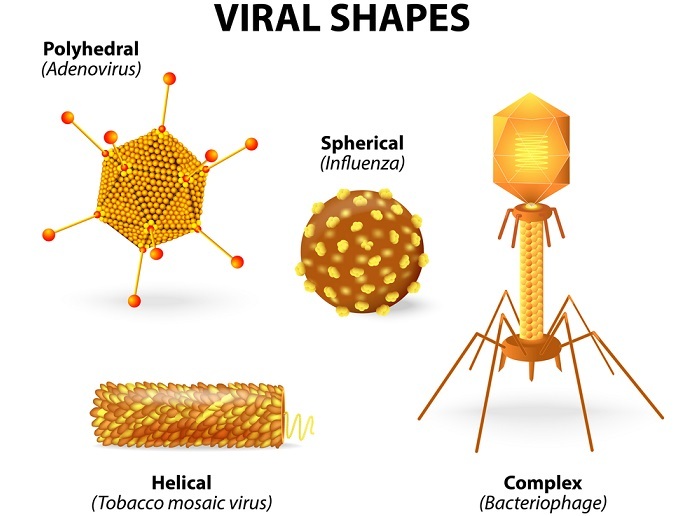
 Data Structure
Data Structure Networking
Networking RDBMS
RDBMS Operating System
Operating System Java
Java MS Excel
MS Excel iOS
iOS HTML
HTML CSS
CSS Android
Android Python
Python C Programming
C Programming C++
C++ C#
C# MongoDB
MongoDB MySQL
MySQL Javascript
Javascript PHP
PHP
- Selected Reading
- UPSC IAS Exams Notes
- Developer's Best Practices
- Questions and Answers
- Effective Resume Writing
- HR Interview Questions
- Computer Glossary
- Who is Who
Virology: An Overview
Introduction to Viruses
A branch of science dealing with the studies on viruses is referred to as Virology. Virus comes from a Latin word which means "poison".
Viruses are the smallest infectious agents or organisms whose size ranges between 20nm and 300nm in diameter. In fact the other microorganisms like Mycoplasma which is usually a bacteria is as small as about 300nm in diameter. These viruses are made up of protein shell or capsid, with or without lipid envelope and viral genome which may be either RNA or DNA.
As these agents do not possess cytoplasm they do not have cytoplasmic organelles like ribosomes, mitochondria etc. and hence they do not synthesize any proteins and generate energy on their own. However these viruses have the capability to synthesize proteins and reproduce within the infected host cell by utilizing its energy. Hence for this reason these viruses are called obligate intracellular parasites.
Virion
This term refers to a complete virus or infectious viral particle. Here all the viral components are present.
Viriod
It refers to the viral nucleic acid entering the host infected by the virus. This term is only applicable in certain stages of RNA replication.

General Characteristics of Viruses
Characteristics of viruses include -
These are ultra-filterable agents whose size ranges between 20nm and 300nm of diameter.
These are only visualized through the electron microscopy.
Smallest viruses belong to the group Parvovirus and Picorna viruses whereas the largest viruses fall under Poxviruses group.
Smallest virus is little larger than the size of ribosome and the largest virus is equal to the size of the smallest bacteria.
Viruses usually not considered as true living organisms as they lack the metabolic properties to replicate and live autonomous. Hence they depend on the host cell.
These are usually considered as intracellular parasites.
Outside the host cell, viruses are called virus particle and considered as non-living organisms which have either DNA or RNA as genetic material but not both and a protein coat called capsid.
Viruses cannot be grown on the non-living medium instead need host cells.
These are not capable of binary fission like any other unicellular organisms which includes Bacteria, Chlamydia, Ricketssiae and Mycoplasma. Viruses divide by a complex way of cell division.
Structure of Virus
The morphology of virus includes a nucleic acid which is surrounded by the capsid.
Capsid
It is composed of small protein units called capsomere. The entire structure of virus with nucleic acid and capsid is termed as nucleocapsid.
Relationship of the capsid to the nucleic acid determines the symmetry of the virus which is the arrangement of both components i.e., nucleic acid and capsid. There are majorly 2 symmetries.
Icosahedron Symmetry: Here the capsid forms a hexagonal shaped structure surrounding the nucleic acid. It is the most common form of symmetry observed in viruses. Except Pox virus which has a complex symmetry other viruses have icosahedron symmetry.
Helical Symmetry: Here the capsid circles likes a helix around the nucleic acid in a virus. Examples - Myxo virus, Rhabdo virus, filovirus and Bunya viruses.

Envelope
It is a lipoproteinous coat like structure which has both protein and lipid part in it. Outer side is usually lipid part and inner embedded structures are protein part. Protein part is usually virus coded and the lipid part of the envelope is derived from the host cell membrane. Most of the viruses are enveloped and the other non-enveloped or naked viruses are most resistant to disinfection and heat.
Non-enveloped Virus: Among DNA viruses are Parvo, Adeno and Popova viruses. RNA viruses are Picorna, Astro, Reo and Calci viruses, Hepatitis A and E viruses.
Life-Cycle of Virus
Viruses cannot grow without a host cell. Hence it infects the host cell and uses the host machinery to replicate its genetic material and make new virus particles. Viruses replicates in a complex manner unlike bacteria which replicates by binary fission. This replication process is grouped into a sequential steps as follows.
Attachment - Most specific in deciding which virus infects the specific cell. This is due to the receptor interaction. Example: HIV Gp120 interacts with CD4 of human cells.
Penetration - Virus penetrates into host cell.
Un-coating - Here capsid is destroyed releasing its nucleic acid into host cell.
Replication or Biosynthesis stage - Here the viral DNA/RNA replicates either in cytoplasm or nucleus. Most of the DNA virus replicates their DNA in nucleus except Pox virus which replicates in cytoplasm and Hepatitis virus replicates partly in nucleus and partly in cytoplasm. Most of the RNA virus replicate in cytoplasm except HIV and Influenza virus which replicates in nucleus.
Maturation or assembly - Positive sense SS RNA behaves as RNA as translates into proteins and replication results in SS RNA molecules which assemble to produce daughter viruses. Negative sense SS RNA first converts to positive sense mRNA which will then undergo translation to produce proteins.
Release - It occurs mostly by budding or host cell lysis.
Classification of Viruses
Based on nature of host cells, viruses are classified as follows.
Animal Viruses: Viruses infecting animals.
Plant Viruses: viruses which infect the plants. Example - Dwarf Mosaic Virus in corn.
Bacterial Viruses (Bacteriophages): Viruses that are able to infect bacterial cells. Examples include T2, T4, T6 phages.
Based on the genetic material, viruses are again classified as below.
DNA Viruses
Most of the DNA viruses have the double stranded DNA except Parvovirus which possess a single stranded DNA.
Examples: Parvovirus, Pox virus, Popova virus, Herpes, Hepatitis B virus, Adenovirus and Bacteriophages.
RNA Viruses
Most of the RNA viruses have single stranded RNA except Reo virus which has the double stranded RNA. Whereas HIV has 2 copies of single stranded RNA. Some of the RNA viruses have the segmented RNA which includes Bunya virus, Influenza virus, Rotavirus and Arenavirus.
SS RNA viruses are again classified as positive sense SS RNA virus or negative sense SS RNA virus which is depended on whether the RNA has positive polarity or negative. Examples: Myxovirus (Paramyxo or Orthomyxoviruses), Arbovirus, Other Hepatitis virus, Picornavirus, Rabies, Retrovirus like HIV, Reo virus like Rotavirus etc.
Based on the presence of viral envelope, viruses are classified as.
Naked Viruses
Enveloped Viruses
Importance of Studying Virology
Fermentation process is mostly affected by the bacterial viruses.
Some of the viruses are used as bio-pesticides to control the pests in agricultural crops.
Some viruses are used in genetic engineering as vectors.
Vaccines which are protective against many viral infections are produced by the cultivation of viruses. As for large scale production of vaccines require huge cultivation of these viruses, studying viruses become much important.
Conclusion
Virology is an important branch of microbiology which is the study of viruses. History of human development was considered to be defined mainly by 3 factors like human conflicts, environmental changes and emergence and prevalence of infectious diseases.
These infectious agents may be of different types like bacteria, protozoa, fungi, viruses and parasitic worms. Viruses are the obligate parasites which requires the other host cell for completion of their life cycle and the growth and development.
The host cells here may be an animal or plant cell. These are infectious particles usually made up of protein shell, viral genome and presence or absence of outer lipid envelope. Viruses do not possess properties like other unicellular organisms.

